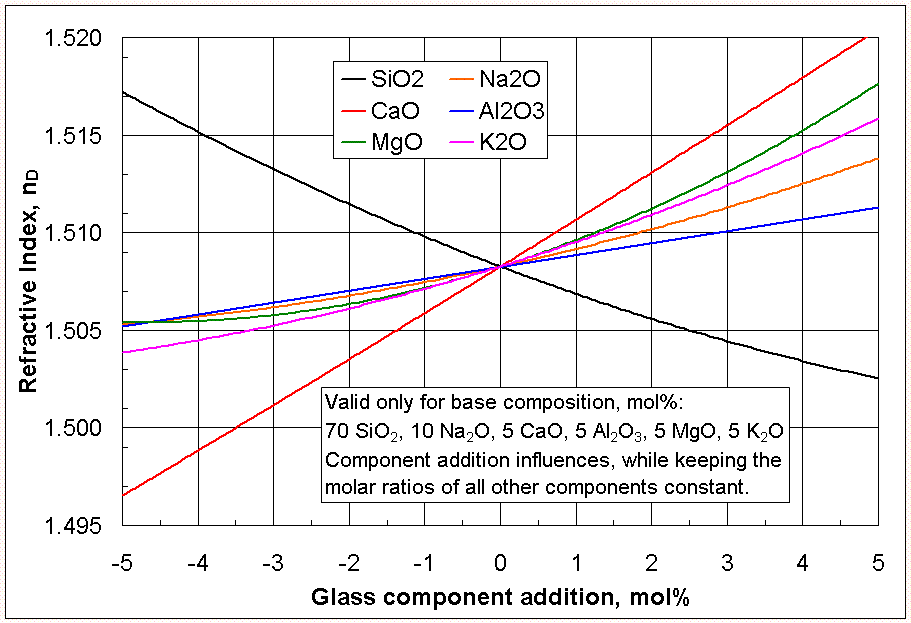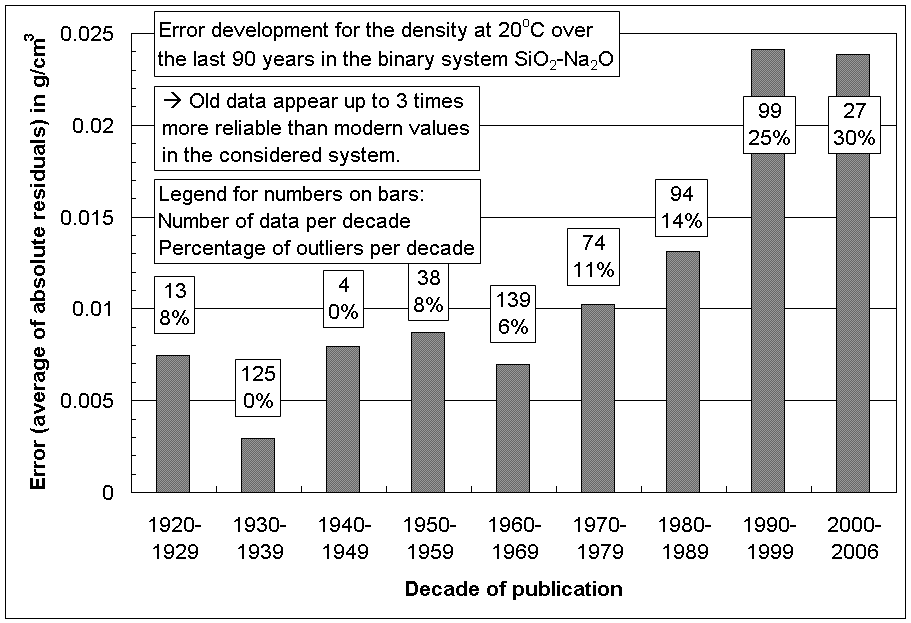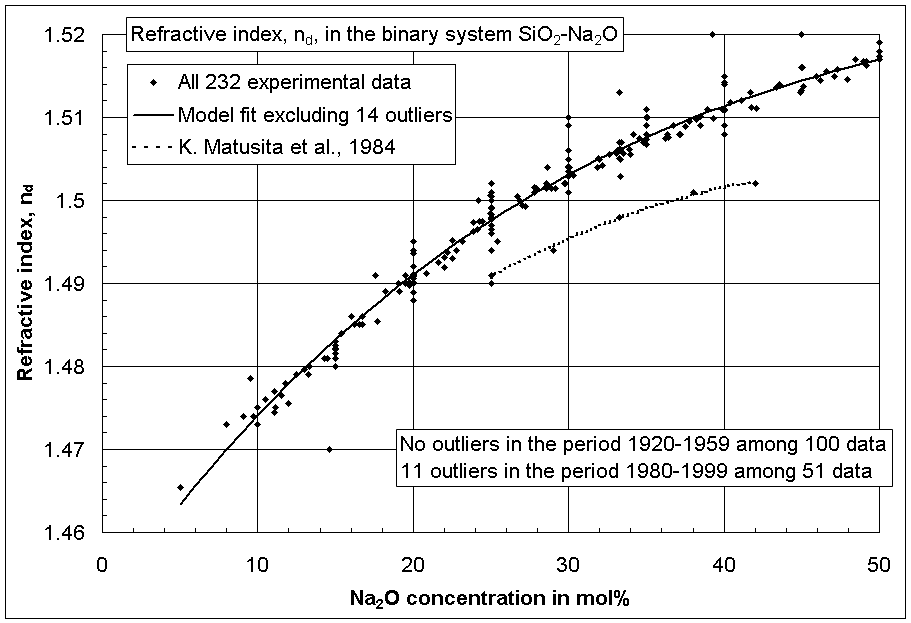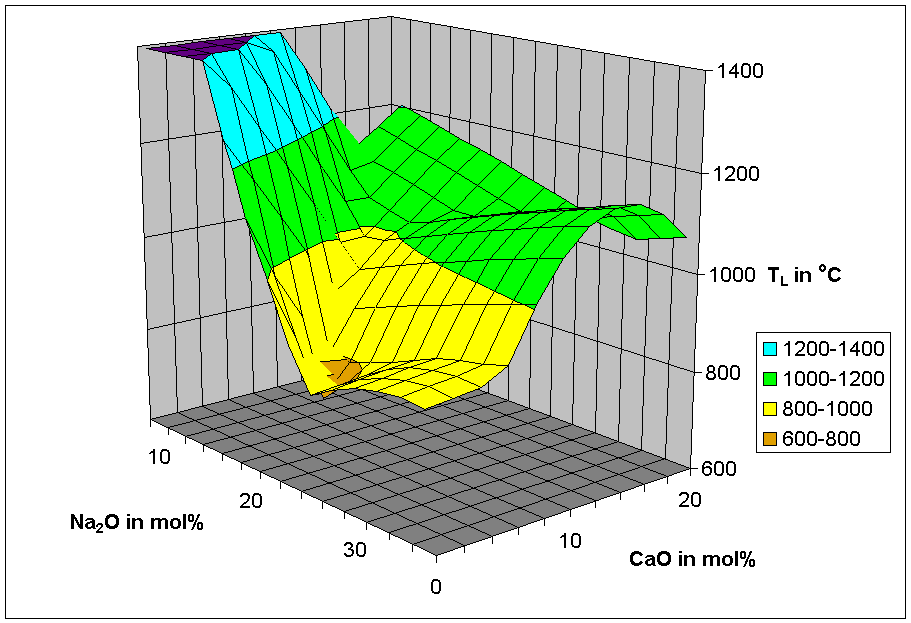
Calculation of glass properties
Encyclopedia

Glass
Glass is an amorphous solid material. Glasses are typically brittle and optically transparent.The most familiar type of glass, used for centuries in windows and drinking vessels, is soda-lime glass, composed of about 75% silica plus Na2O, CaO, and several minor additives...
properties of interest or glass behavior under certain conditions (e.g., during production) without experimental investigation, based on past data and experience, with the intention to save time, material, financial, and environmental resources, or to gain scientific insight. It was first practised at the end of the 19th century by A. Winkelmann and O. Schott
Otto Schott
Friedrich Otto Schott was a German chemist, glass technologist, and the inventor of borosilicate glass. He was the son of a window glass maker, Simon Schott. From 1870 to 1873 Schott studied chemical technology at the technical college in Aachen and at the universities of Würzburg and Leipzig...
. The combination of several glass models together with other relevant functions can be used for optimization
Optimization (mathematics)
In mathematics, computational science, or management science, mathematical optimization refers to the selection of a best element from some set of available alternatives....
and six sigma
Six Sigma
Six Sigma is a business management strategy originally developed by Motorola, USA in 1986. , it is widely used in many sectors of industry.Six Sigma seeks to improve the quality of process outputs by identifying and removing the causes of defects and minimizing variability in manufacturing and...
procedures. In the form of statistical analysis glass modeling can aid with accreditation
Accreditation
Accreditation is a process in which certification of competency, authority, or credibility is presented.Organizations that issue credentials or certify third parties against official standards are themselves formally accredited by accreditation bodies ; hence they are sometimes known as "accredited...
of new data, experimental procedures, and measurement institutions (glass laboratories).
History
Historically, the calculation of glass properties is directly related to the founding of glass scienceScience
Science is a systematic enterprise that builds and organizes knowledge in the form of testable explanations and predictions about the universe...
. At the end of the 19th century the physicist Ernst Abbe developed equations that allow calculating the design of optimized optical microscope
Microscope
A microscope is an instrument used to see objects that are too small for the naked eye. The science of investigating small objects using such an instrument is called microscopy...
s in Jena
Jena
Jena is a university city in central Germany on the river Saale. It has a population of approx. 103,000 and is the second largest city in the federal state of Thuringia, after Erfurt.-History:Jena was first mentioned in an 1182 document...
, Germany
Germany
Germany , officially the Federal Republic of Germany , is a federal parliamentary republic in Europe. The country consists of 16 states while the capital and largest city is Berlin. Germany covers an area of 357,021 km2 and has a largely temperate seasonal climate...
, stimulated by co-operation with the optical workshop of Carl Zeiss
Carl Zeiss
Carl Zeiss was a German maker of optical instruments commonly known for the company he founded, Carl Zeiss Jena . Zeiss made contributions to lens manufacturing that have aided the modern production of lenses...
. Before Ernst Abbe's time the building of microscope
Microscope
A microscope is an instrument used to see objects that are too small for the naked eye. The science of investigating small objects using such an instrument is called microscopy...
s was mainly a work of art and experienced craftsmanship, resulting in very expensive optical microscope
Microscope
A microscope is an instrument used to see objects that are too small for the naked eye. The science of investigating small objects using such an instrument is called microscopy...
s with variable quality. Now Ernst Abbe knew exactly how to construct an excellent microscope, but unfortunately, the required lenses
Lens (optics)
A lens is an optical device with perfect or approximate axial symmetry which transmits and refracts light, converging or diverging the beam. A simple lens consists of a single optical element...
and prisms
Prism (optics)
In optics, a prism is a transparent optical element with flat, polished surfaces that refract light. The exact angles between the surfaces depend on the application. The traditional geometrical shape is that of a triangular prism with a triangular base and rectangular sides, and in colloquial use...
with specific ratios of refractive index
Refractive index
In optics the refractive index or index of refraction of a substance or medium is a measure of the speed of light in that medium. It is expressed as a ratio of the speed of light in vacuum relative to that in the considered medium....
and dispersion
Dispersion (optics)
In optics, dispersion is the phenomenon in which the phase velocity of a wave depends on its frequency, or alternatively when the group velocity depends on the frequency.Media having such a property are termed dispersive media...
did not exist. Ernst Abbe was not able to find answers to his needs from glass artists and engineers; glass making was not based on science at this time.
In 1879 the young glass engineer Otto Schott
Otto Schott
Friedrich Otto Schott was a German chemist, glass technologist, and the inventor of borosilicate glass. He was the son of a window glass maker, Simon Schott. From 1870 to 1873 Schott studied chemical technology at the technical college in Aachen and at the universities of Würzburg and Leipzig...
sent Abbe glass samples with a special composition (lithium
Lithium
Lithium is a soft, silver-white metal that belongs to the alkali metal group of chemical elements. It is represented by the symbol Li, and it has the atomic number 3. Under standard conditions it is the lightest metal and the least dense solid element. Like all alkali metals, lithium is highly...
silicate glass) that he had prepared himself and that he hoped to show special optical
Optics
Optics is the branch of physics which involves the behavior and properties of light, including its interactions with matter and the construction of instruments that use or detect it. Optics usually describes the behavior of visible, ultraviolet, and infrared light...
properties. Following measurements by Ernst Abbe, Schott's glass samples did not have the desired properties, and they were also not as homogeneous as desired. Nevertheless, Ernst Abbe invited Otto Schott to work on the problem further and to evaluate all possible glass components systematically. Finally, Schott succeeded in producing homogeneous glass samples, and he invented borosilicate glass
Borosilicate glass
Borosilicate glass is a type of glass with the main glass-forming constituents silica and boron oxide. Borosilicate glasses are known for having very low coefficients of thermal expansion , making them resistant to thermal shock, more so than any other common glass...
with the optical properties Abbe needed. These inventions gave rise to the well-known companies Zeiss and Schott Glass
Schott Glass
SCHOTT AG is a German manufacturer of high-quality industrial glass products, its main markets are household appliances, pharmaceutical industries, solar energy, electronics, optics as well as automotive...
(see also Timeline of microscope technology
Timeline of microscope technology
Timeline of microscope technology* 1590 - Dutch spectacle-makers Hans Jansen and his son Zacharias Jansen, claimed by later writers to have invented a compound microscope....
). Systematic glass research was born. In 1908, Eugene Sullivan founded glass research also in the United States (Corning
Corning (city), New York
Corning is a city in Steuben County, New York, United States, on the Chemung River. The population was 10,842 at the 2000 census. It is named for Erastus Corning, an Albany financier and railroad executive who was an investor in the company that developed the community.- Overview :The city of...
, New York
New York
New York is a state in the Northeastern region of the United States. It is the nation's third most populous state. New York is bordered by New Jersey and Pennsylvania to the south, and by Connecticut, Massachusetts and Vermont to the east...
).
At the beginning of glass research it was most important to know the relation between the glass composition and its properties. For this purpose Otto Schott introduced the additivity principle in several publications for calculation of glass properties. This principle implies that the relation between the glass composition and a specific property is linear to all glass component concentrations, assuming an ideal mixture, with Ci and bi representing specific glass component concentrations and related coefficients respectively in the equation below. The additivity principle is a simplification and only valid within narrow composition ranges as seen in the displayed diagrams for the refractive index and the viscosity. Nevertheless, the application of the additivity principle lead the way to many of Schott’s inventions, including optical glasses, glasses with low thermal expansion for cooking and laboratory ware (Duran
Borosilicate glass
Borosilicate glass is a type of glass with the main glass-forming constituents silica and boron oxide. Borosilicate glasses are known for having very low coefficients of thermal expansion , making them resistant to thermal shock, more so than any other common glass...
), and glasses with reduced freezing point depression for mercury thermometer
Thermometer
Developed during the 16th and 17th centuries, a thermometer is a device that measures temperature or temperature gradient using a variety of different principles. A thermometer has two important elements: the temperature sensor Developed during the 16th and 17th centuries, a thermometer (from the...
s. Subsequently, English and Gehlhoff et al. published similar additive glass property calculation models. Schott’s additivity principle is still widely in use today in glass research and technology.
- Additivity Principle:

Global models


Glass
Glass is an amorphous solid material. Glasses are typically brittle and optically transparent.The most familiar type of glass, used for centuries in windows and drinking vessels, is soda-lime glass, composed of about 75% silica plus Na2O, CaO, and several minor additives...
compositions were studied, resulting in millions of published glass properties, collected in glass databases
Glass databases
Glass databases are a collection of glass compositions, glass properties, glass models, associated trademark names, patents etc. These data were collected from publications in scientific papers and patents, from personal communication with scientists and engineers, and other relevant...
. This huge pool of experimental data was not investigated as a whole, until Bottinga,, Kucuk, Priven, Choudhary, Mazurin, and Fluegel published their global glass models, using various approaches. In contrast to the models by Schott the global models consider many independent data sources, making the model estimates more reliable. In addition, global models can reveal and quantify non-additive influences of certain glass component combinations on the properties, such as the mixed-alkali effect as seen in the diagram on the right, or the boron anomaly. Global models also reflect interesting developments of glass property measurement accuracy, e.g., a decreasing accuracy of experimental data in modern scientific literature for some glass properties, shown in the diagram. They can be used for accreditation of new data, experimental procedures, and measurement institutions (glass laboratories). In the following sections (except melting enthalpy) empirical
Empirical
The word empirical denotes information gained by means of observation or experimentation. Empirical data are data produced by an experiment or observation....
modeling techniques are presented, which seem to be a successful way for handling huge amounts of experimental data. The resulting models are applied in contemporary engineering and research for the calculation of glass properties.
Non-empirical (deductive) glass models exist. They are often not created to obtain reliable glass property predictions in the first place (except melting enthalpy), but to establish relations among several properties (e.g. atomic radius
Atomic radius
The atomic radius of a chemical element is a measure of the size of its atoms, usually the mean or typical distance from the nucleus to the boundary of the surrounding cloud of electrons...
, atomic mass
Atomic mass
The atomic mass is the mass of a specific isotope, most often expressed in unified atomic mass units. The atomic mass is the total mass of protons, neutrons and electrons in a single atom....
, chemical bond strength and angles
Chemical bond
A chemical bond is an attraction between atoms that allows the formation of chemical substances that contain two or more atoms. The bond is caused by the electromagnetic force attraction between opposite charges, either between electrons and nuclei, or as the result of a dipole attraction...
, chemical valency
Valence (chemistry)
In chemistry, valence, also known as valency or valence number, is a measure of the number of bonds formed by an atom of a given element. "Valence" can be defined as the number of valence bonds...
, heat capacity
Heat capacity
Heat capacity , or thermal capacity, is the measurable physical quantity that characterizes the amount of heat required to change a substance's temperature by a given amount...
) to gain scientific insight. In future, the investigation of property relations in deductive models may ultimately lead to reliable predictions for all desired properties, provided the property relations are well understood and all required experimental data are available.
Methods
Glass properties and glass behavior during production can be calculated through statistical analysis of glass databasesGlass databases
Glass databases are a collection of glass compositions, glass properties, glass models, associated trademark names, patents etc. These data were collected from publications in scientific papers and patents, from personal communication with scientists and engineers, and other relevant...
such as GE-SYSTEM
SciGlass and Interglad,
sometimes combined with the finite element method
Finite element method
The finite element method is a numerical technique for finding approximate solutions of partial differential equations as well as integral equations...
. For estimating the melting enthalpy thermodynamic databases are used.
Linear regression

Crystallization
Crystallization is the process of formation of solid crystals precipitating from a solution, melt or more rarely deposited directly from a gas. Crystallization is also a chemical solid–liquid separation technique, in which mass transfer of a solute from the liquid solution to a pure solid...
(e.g., liquidus temperature
Liquidus temperature
The liquidus temperature, TL or Tliq, is mostly used for glasses, alloys and rocks. It specifies the maximum temperature at which crystals can co-exist with the melt in thermodynamic equilibrium. Above the liquidus temperature the material is homogeneous...
) or phase separation, linear regression
Linear regression
In statistics, linear regression is an approach to modeling the relationship between a scalar variable y and one or more explanatory variables denoted X. The case of one explanatory variable is called simple regression...
can be applied using common polynomial
Polynomial
In mathematics, a polynomial is an expression of finite length constructed from variables and constants, using only the operations of addition, subtraction, multiplication, and non-negative integer exponents...
functions up to the third degree. Below is an example equation of the second degree. The C-values are the glass component concentrations like Na2O or CaO in percent or other fractions, the b-values are coefficients, and n is the total number of glass components. The glass main component silica (SiO2) is excluded in the equation below because of over-parametrization due to the constraint that all components sum up to 100%. Many terms in the equation below can be neglected based on correlation
Correlation
In statistics, dependence refers to any statistical relationship between two random variables or two sets of data. Correlation refers to any of a broad class of statistical relationships involving dependence....
and significance
Statistical significance
In statistics, a result is called statistically significant if it is unlikely to have occurred by chance. The phrase test of significance was coined by Ronald Fisher....
analysis. Systematic errors such as seen in the picture are quantified by dummy variables. Further details and examples are available in an online tutorial by Fluegel.

Non-linear regression

Liquidus temperature
The liquidus temperature, TL or Tliq, is mostly used for glasses, alloys and rocks. It specifies the maximum temperature at which crystals can co-exist with the melt in thermodynamic equilibrium. Above the liquidus temperature the material is homogeneous...
has been modeled by non-linear regression using neural networks
Neural Networks
Neural Networks is the official journal of the three oldest societies dedicated to research in neural networks: International Neural Network Society, European Neural Network Society and Japanese Neural Network Society, published by Elsevier...
and disconnected peak functions. The disconnected peak functions approach is based on the observation that within one primary crystalline phase field linear regression can be applied and at eutectic points sudden changes occur.
Glass melting enthalpy
The glass melting enthalpy reflects the amount of energy needed to convert the mix of raw materials (batch) to a melt glass. It depends on the batch and glass compositions, on the efficiency of the furnace and heat regeneration systems, the average residence time of the glass in the furnace, and many other factors. A pioneering article about the subject was written by Carl Kröger in 1953.Finite element method
For modeling of the glass flow in a glass melting furnace the finite element methodFinite element method
The finite element method is a numerical technique for finding approximate solutions of partial differential equations as well as integral equations...
is applied commercially, based on data or models for viscosity
Viscosity
Viscosity is a measure of the resistance of a fluid which is being deformed by either shear or tensile stress. In everyday terms , viscosity is "thickness" or "internal friction". Thus, water is "thin", having a lower viscosity, while honey is "thick", having a higher viscosity...
, density
Density
The mass density or density of a material is defined as its mass per unit volume. The symbol most often used for density is ρ . In some cases , density is also defined as its weight per unit volume; although, this quantity is more properly called specific weight...
, thermal conductivity
Thermal conductivity
In physics, thermal conductivity, k, is the property of a material's ability to conduct heat. It appears primarily in Fourier's Law for heat conduction....
, heat capacity
Heat capacity
Heat capacity , or thermal capacity, is the measurable physical quantity that characterizes the amount of heat required to change a substance's temperature by a given amount...
, absorption spectra, and other relevant properties of the glass melt. The finite element method may also be applied to glass forming processes.
Optimization
It is often required to optimizeOptimization (mathematics)
In mathematics, computational science, or management science, mathematical optimization refers to the selection of a best element from some set of available alternatives....
several glass properties simultaneously, including production costs.
GE-SYSTEM
This can be performed, e.g., by simplex search, or in a spreadsheet as follows:
- Listing of the desired properties;
- Entering of models for the reliable calculation of properties based on the glass composition, including a formula for estimating the production costs;
- Calculation of the squares of the differences (errors) between desired and calculated properties;
- Reduction of the sum of square errors using the Solver option in Microsoft ExcelMicrosoft ExcelMicrosoft Excel is a proprietary commercial spreadsheet application written and distributed by Microsoft for Microsoft Windows and Mac OS X. It features calculation, graphing tools, pivot tables, and a macro programming language called Visual Basic for Applications...
with the glass components as variables. Other software (e.g. Microcal OriginOrigin (software)Origin is a proprietary computer program for interactive scientific graphing and data analysis. It is produced by OriginLab Corporation, and runs on Microsoft Windows...
) can also be used to perform these optimizationsOptimization (mathematics)In mathematics, computational science, or management science, mathematical optimization refers to the selection of a best element from some set of available alternatives....
.
It is possible to weight the desired properties differently. Basic information about the principle can be found in an article by Huff et al. The combination of several glass models together with further relevant technological and financial functions can be used in six sigma
Six Sigma
Six Sigma is a business management strategy originally developed by Motorola, USA in 1986. , it is widely used in many sectors of industry.Six Sigma seeks to improve the quality of process outputs by identifying and removing the causes of defects and minimizing variability in manufacturing and...
optimization.

